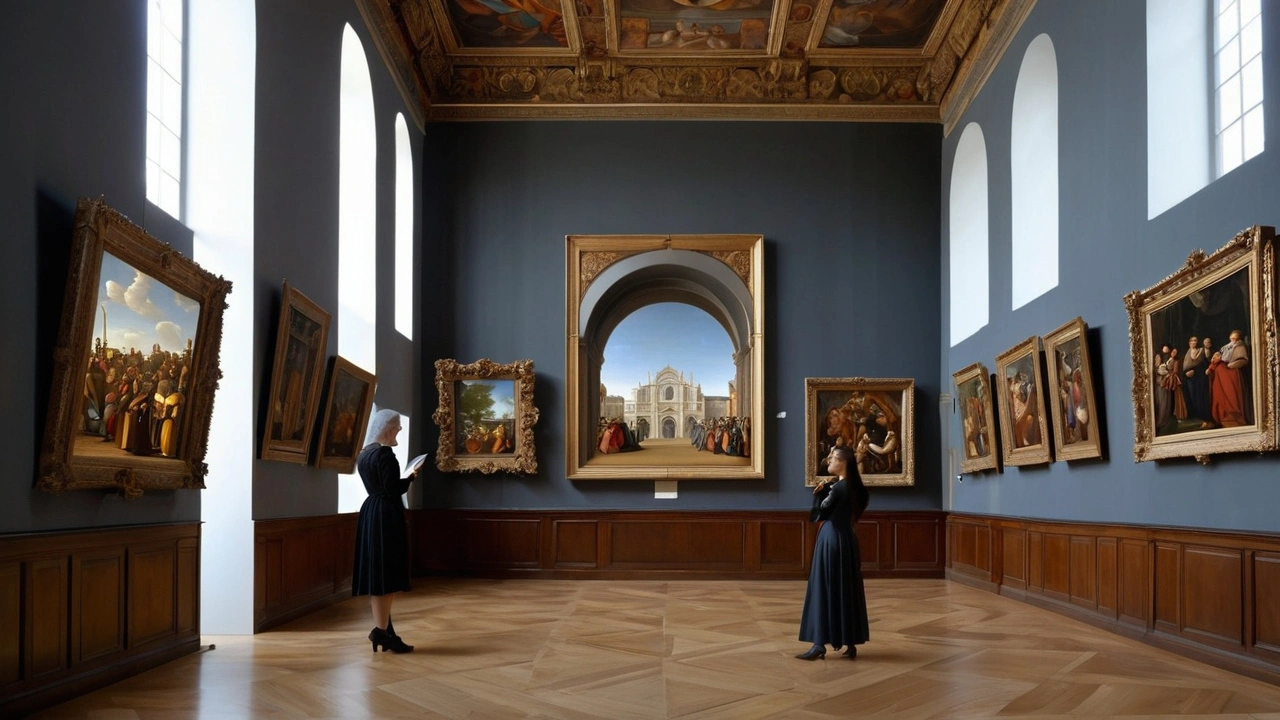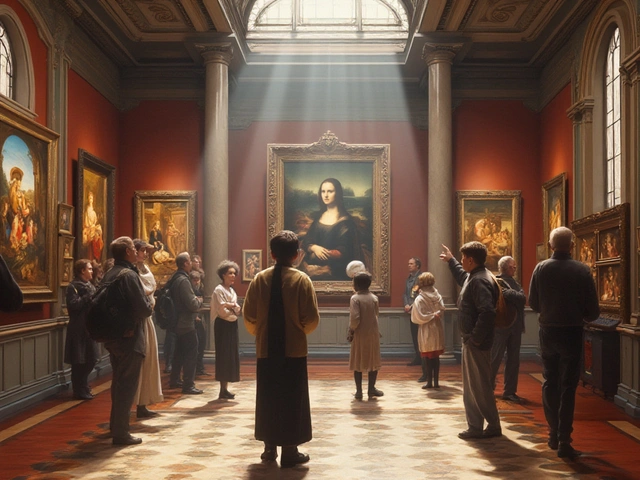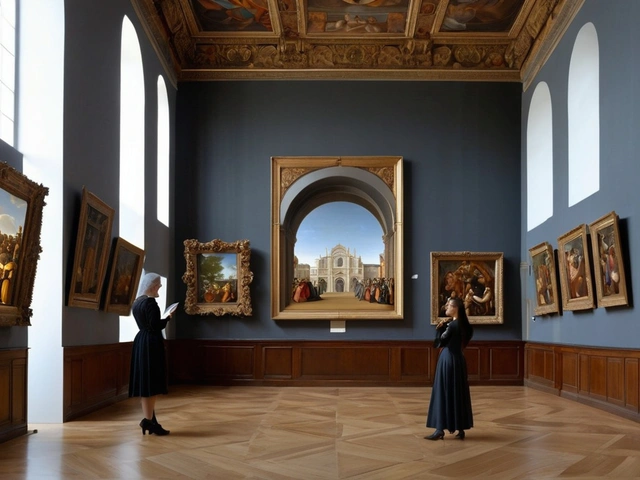The Renaissance was a period of great cultural and artistic flourishing. One of the most intriguing aspects of Renaissance paintings is the way artists used symbolism to convey deeper meanings and messages. Understanding these symbols can transform the way we see and appreciate these masterpieces.
By familiarizing yourself with the common themes and motifs of the time, you can start to decode the language of these artworks. From religious imagery to references to mythology, each element in a painting holds significance.
Exploring these symbols not only enhances our understanding of the past but also connects us to universal themes that still resonate today. Whether you're an art enthusiast or just curious, learning to decipher these codes unlocks a richer experience of Renaissance art.
- The Hidden Language of Symbols
- Religious Imagery and Its Significance
- Nature and Mythology in Renaissance Art
- Iconography of Everyday Objects
- Tips for Interpreting Symbolism in Paintings
The Hidden Language of Symbols
Renaissance artists were not only talented in creating visually stunning pieces but also adept at embedding layers of meaning within their work. They often used symbols as a way to convey messages, share deeper truths, and connect with viewers on a more profound level. These symbols provided insight into the artist's thoughts, the era’s cultural context, and the intended moral or philosophical lessons.
In this intricate visual language, something as simple as the placement of a figure or an everyday object in a painting could hold significant meaning. For instance, the lily flower often represented purity and was associated with the Virgin Mary in religious contexts. Similarly, an apple could symbolize sin or innocence, depending on the narrative context.
Many artists used colors strategically to emphasize certain aspects and messages in their work. Red could signify passion or martyrdom, while blue often indicated the heavens or divinity. These colors weren't chosen randomly but carried immense weight in communicating the artwork's essence. By understanding these choices, viewers can delve into the artists’ intent and the painting’s story.
Symbols were also a way to embed socio-political commentary. For example, the inclusion of certain animals like lions or dogs could refer to traits like courage or loyalty. In some cases, you might find a scene that, at first glance, seems ordinary. However, with a closer look, you might notice subtle references to contemporary political events or social issues the artist wanted to highlight.
One famous example is Leonardo da Vinci's 'The Last Supper,' where each apostle's facial expression and body language aren't just artistic choices but carefully crafted symbols reflecting their personalities and destinies. Such details demonstrate da Vinci's mastery of using symbols to add depth and complexity to his work.
"Symbols are the language of something invisible spoken in the visible world." — Gerhart Hauptmann
Understanding these symbols requires a combination of historical knowledge, cultural context, and a bit of detective work. It’s like learning to read a different language. But once you start recognizing and understanding these symbols, the paintings come alive in a whole new way, revealing stories and meanings that are not immediately apparent.
For those eager to dive deeper, it’s useful to reference art history books and scholarly articles that analyze specific works. Museum plaques and guided tours often provide valuable insights and context that can enhance our understanding of symbolism in these masterpieces. Exploring multiple sources can give a more rounded understanding and appreciation of the depth found in Renaissance art.
Religious Imagery and Its Significance
Renaissance art is renowned for its deep-rooted religious themes and imagery. During this period, Europe was predominantly Christian, and the Church had a significant influence on art and culture. As a result, many paintings of this era are imbued with Christian symbolism, offering viewers a multifaceted experience that transcends the visual.
An excellent example of religious symbolism in Renaissance art is the use of halos. Halos are typically depicted as circles of light around the heads of saints and angels. This simple yet powerful symbol was used to denote holiness and the divine nature of the figure. In Leonardo da Vinci's 'The Last Supper,' halos are only subtly hinted at, reflecting Leonardo’s dedication to naturalism and representing a transition in artistic conventions of the time.
Another significant symbol is the lily, often seen in paintings of the Annunciation, a moment when the Angel Gabriel tells Mary that she will conceive the Son of God. The lily in these scenes represents purity and Mary's chastity. Such imagery can be found in the works of Fra Angelico and Sandro Botticelli. Botticelli’s 'Madonna of the Pomegranate' features Mary holding a pomegranate, a symbol of Christ’s resurrection and the unity of believers.
Attention to detail was paramount, as artists would meticulously include references that communicated deeper theological messages. For example, the lamb often symbolized Jesus Christ and His sacrifice for humanity. In Jan van Eyck’s 'Ghent Altarpiece,' the Lamb of God is portrayed on an altar, surrounded by adoring angels, symbolizing Christ’s sacrificial death and the salvation of mankind.
Museums offer great resources to explore religious symbolism. Still, one need not be a seasoned art historian to practice iconography – the study of symbols in art. Identifying common symbols like the cross, fish, and dove can enhance our understanding and appreciation of these masterpieces. As the French art historian Émile Male once remarked, “The Middle Ages and the Renaissance produced symbolic art in complete security of mind and heart.”
Part of what makes Renaissance art so captivating is this blend of visual beauty and rich, layered meaning. Next time you encounter a Renaissance painting, take a moment to look beyond the surface. Consider the symbolic elements within the artwork and the stories they tell. Each piece is a testament to the profound spirituality and artistic skill of the era, revealing the inseparable connection between faith and art.
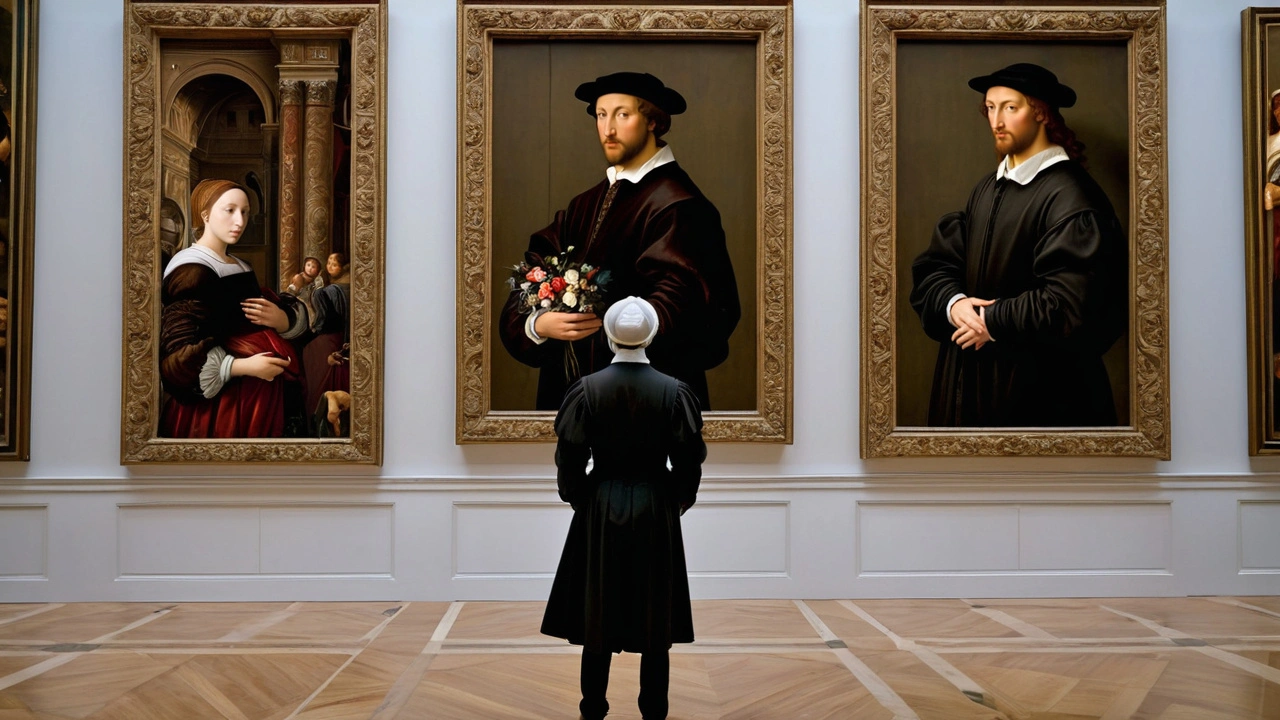
Nature and Mythology in Renaissance Art
The Renaissance era was a time when artists looked back to the classical knowledge from Ancient Greece and Rome. They revived mythological themes and stories, turning them into visual spectacles that fascinated viewers. Nature itself, with its beauty and majesty, became a rich source of inspiration for these artists. Combining nature and mythology allowed Renaissance painters to create complex and layered narratives. This fusion made their works both visually appealing and intellectually stimulating.
Mythological subjects offered Renaissance artists a way to explore themes like love, heroism, and morality. For instance, Sandro Botticelli’s masterpiece, “The Birth of Venus,” portrays the goddess Venus emerging from the sea. The natural elements like seashells, waves, and the gentle breeze, coupled with the figures from mythology, create a harmonious and symbolic composition. Venus stands as a symbol of beauty and love, making this painting one of the most celebrated works of that period.
Apart from depicting mythological stories, nature in Renaissance paintings often symbolized deeper philosophical meanings. Trees, flowers, animals, and even the landscape itself had specific connotations. For example, the oak tree symbolized strength and endurance, while the white lily stood for purity. Such symbols were not just decorative but held significant meaning, inviting viewers to look beyond the surface and ponder the deeper message conveyed by the artist.
Leonardo da Vinci was a master of using both nature and mythology to enrich his works. In “Leda and the Swan,” da Vinci illustrates the myth of Zeus, who transforms into a swan to seduce Leda. The intricate details of the swan’s feathers, the soft textures of Leda’s skin, and the lush landscape surrounding them highlight da Vinci’s extraordinary ability to blend natural beauty with mythological storytelling. This painting, although now lost, carried an aura of mystique and wonder, a testament to da Vinci’s genius.
Another fascinating example is Titian’s “Bacchus and Ariadne,” which depicts the god Bacchus discovering the abandoned Ariadne. The intertwined vines, the exuberant god of wine, and the startled yet serene Ariadne combine to narrate a story of divine intervention with human emotions. The lush natural setting, with its rich greens and vibrant flowers, creates a backdrop that makes the mythological event feel almost real.
As art historian Kenneth Clark once noted, “The great artist is the simplifier.” In Renaissance art, this meant distilling complex mythological narratives and the beauty of nature into compelling visual form.
When visiting a museum or studying Renaissance paintings, observing the natural elements and mythological references can offer a new dimension of appreciation. Ask yourself what the landscape, flora, fauna, and mythical figures might signify. By delving into these details, you become part of the continuing conversation that started centuries ago with the artists themselves.
Understanding the symbols of nature and mythology in Renaissance art is like learning a new language. It’s a skill that grows with practice and enhances your connection to these timeless works. Armed with this knowledge, each painting you encounter becomes a richer, more rewarding experience.
Iconography of Everyday Objects
In Renaissance art, everyday objects were often imbued with deeper, symbolic meanings that hinted at themes ranging from faith and morality to love and power. Understanding the iconography of these objects can transform our interpretation of a painting, revealing hidden narratives that aren't immediately obvious.
A popular example is the use of fruit in Renaissance paintings. Apples commonly symbolize sin and the fall of man, linking back to the biblical story of Adam and Eve. On the other hand, grapes often represent the blood of Christ, connecting to themes of redemption and salvation. It’s fascinating how something as ordinary as fruit can carry such weighty implications.
Flowers also play a significant role in symbolism. The lily, for instance, is a symbol of purity and is often associated with the Virgin Mary. Another is the rose, which has multiple meanings: red roses can symbolize the martyrdom of Christ, while white roses stand for purity and the Virgin Mary. Renaissance artists cleverly utilized these motifs to communicate with an audience well-versed in these emblematic meanings.
Domestic objects like books, musical instruments, and household items have their own iconographic significance. Books typically symbolize wisdom and knowledge, a motif seen in countless depictions of scholars and saints. Musical instruments, particularly the lute, often symbolize harmony but can also imply fleeting pleasure or the transience of life. Household items like candles and mirrors, meanwhile, are rich in allegory. A burning candle can represent the human soul or the passage of time, while a mirror stands for truth or vanity.
Food and drink also carry symbolic meanings. Bread, for instance, is often used to represent the body of Christ, reinforcing religious connotations. Wine, which appears frequently, symbolizes not just the blood of Christ but also celebration and opulence. Through the depiction of these items, artists could subtly convey messages about religious beliefs, social status, and moral lessons.
Colors themselves were not arbitrary choices in Renaissance paintings. They were loaded with meaning. Blue often represented divinity or the heavens, as it was one of the most expensive pigments and frequently used in depictions of the Virgin Mary. Red symbolized passion, love, and sometimes the blood of martyrdom, while green could signify rebirth, nature, or fertility. By noting the colors of everyday objects in a painting, one gains insight into its deeper meanings.
"Symbols are the language of something invisible spoken in the visible world." — Gertrud von Le Fort, emphasizing how objects serve as visual metaphors.
Understanding the iconography of everyday objects in Renaissance paintings helps peel back layers of meaning that might not be immediately apparent. This knowledge transforms a passive viewing experience into an active engagement with the artwork. By recognizing these symbols, one can appreciate the artist's intent and the cultural context in which the work was created, making each piece of art a richer experience.
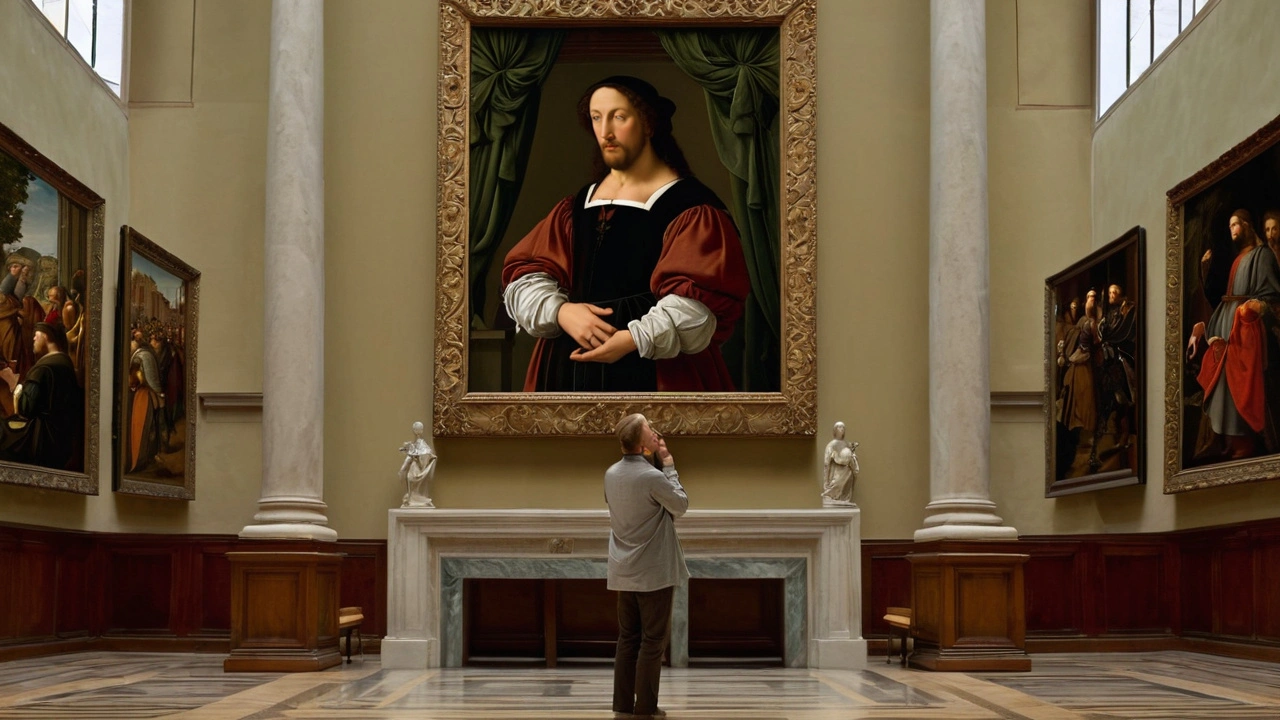
Tips for Interpreting Symbolism in Paintings
Understanding symbolism in Renaissance paintings can be both rewarding and challenging. Many symbols have layers of meaning, often specific to the time and culture in which the artwork was created. To start, it's helpful to familiarize yourself with the religious, mythological, and cultural context of the period. This knowledge will provide a framework for interpreting the visual language artists used.
One essential tip is to pay attention to color symbolism. For instance, the color blue is often associated with the Virgin Mary, symbolizing purity and heavenly grace. Gold, frequently used in halos or backgrounds, signifies divinity and holiness. Each color in a painting was chosen deliberately and can provide clues to the deeper meaning behind the work. Consulting contemporary sources or scholarly works can be beneficial in understanding these choices.
It's also useful to note the role of animals in these paintings. Animals were not just decorative but carried significant meanings. For example, a lamb often represents Christ, as in the “Lamb of God” motif, symbolizing innocence and sacrifice. Peacocks in Renaissance art can symbolize immortality due to the ancient belief that their flesh did not decay. These allegories helped convey complex religious ideas in a digestible visual form.
Another good practice is to look at the everyday objects depicted. Items such as keys, fruit, or flowers can hold significant meanings. For instance, keys often symbolize Saint Peter and represent access to heaven. Similarly, fruit like apples might refer to the story of Adam and Eve, symbolizing original sin. Understanding these objects' meanings can open up new layers of interpretation.
Identifying gestures and postures can also aid in understanding. The position of hands, the direction of a gaze, or the posture of figures often convey specific narratives or emotional states. For example, an upward gaze may indicate divine inspiration or communication with God. By paying close attention to these details, you can start to piece together the story the artist is telling.
Studying works side-by-side can be enlightening. By comparing different paintings of the same subject, such as the Annunciation, you can see how various artists approached similar themes and motifs differently. Additionally, learning about the artist's life and other works can provide valuable context, shedding light on recurring symbols and themes across their body of work.
Lastly, don’t underestimate the importance of seeking expert advice. Art historians and scholars have dedicated years to studying these works and can offer invaluable insights. Visiting museums with curated tours or attending lectures can greatly enhance your understanding. Additionally, there are numerous books and online resources available that delve into Renaissance art symbolism in detail.
“The language of symbols is so universal it can cross all cultural and temporal boundaries,” says art historian Erwin Panofsky, emphasizing the importance of a deep understanding of the era's context when interpreting art.
Engaging with Renaissance paintings on this level is like piecing together a fascinating historical puzzle. As you develop your skills in interpreting these symbols, you'll find yourself more connected to the artwork and enriched by the stories they tell. Take your time, enjoy the process, and don't be afraid to explore the vast and intricate world of Renaissance art.

